Abu Dhabi and Dubai: Two Cities, One Unforgettable Experience
Rising out of the desert, these dazzling cities in the United Arab Emirates draw in travelers with stunning architecture and over-the-top attractions
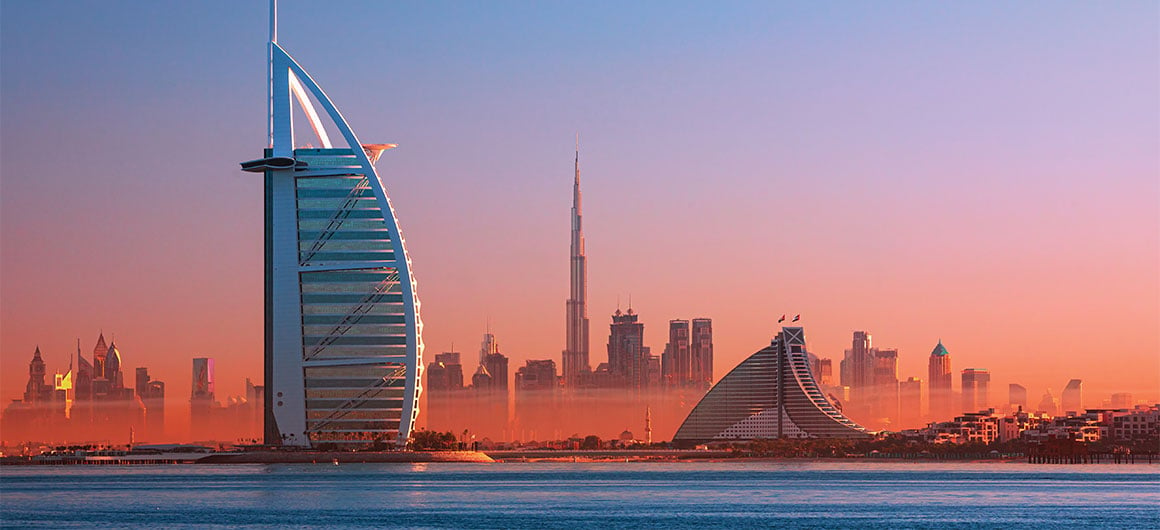
Teetering high atop a camel, my legs straddling its coarse-haired hump, I bob up and down like a buoy in a sea of sand as our caravan of curious tourists trods through the Arabian Desert in the United Arab Emirates (UAE). The camel’s name is Don, an unexpectedly American-sounding moniker that makes me chuckle. After about a 45-minute journey, we stop to witness the sharp and swift hunting skills of a peregrine falcon. Camels and falcons were crucial to the nomadic Bedoudins, an ancient desert civilization that dates back more than 3,000 years.

Our desert safari tour ends at a magical torch-lit oasis in the Dubai Desert Conservation Reserve. Is this a mirage? My senses are overcome with the rich scent of Arabic coffee, the taste of traditional reqaq bread, and the look and feel of soft, ornately woven rugs blanketing the sand. Under elegant dining tents, my fellow tour guests and I feast on traditional Emirati cuisine such as lentil soup, grilled spiced lamb, fragrant rice, vegetable thareed (stew), fresh fruit, luqaimat (donuts, covered in date syrup) and warm cinnamon tea. As the stars shine brightly overhead, we laugh and dance to the beat of traditional drums.
Later, aboard a shuttle bus back to the pulsating atmosphere of Dubai, I am fascinated by the juxtaposition of the serene desert landscape I’ve just left and the bustling city where I am staying that night.
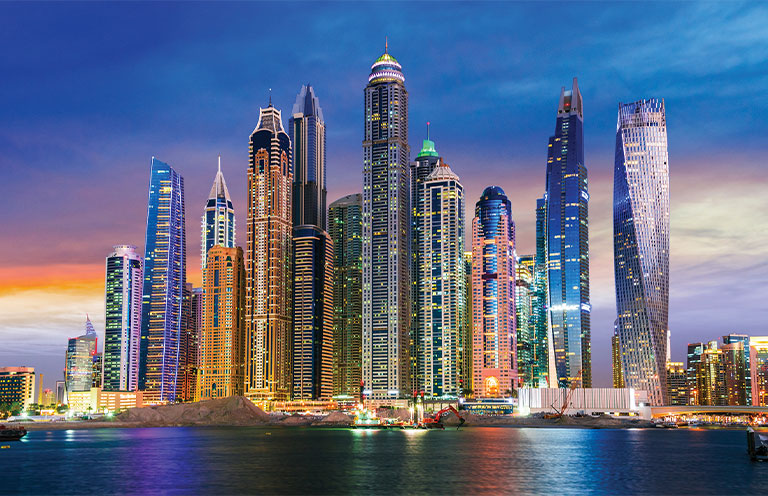
The UAE: A country of innovation and heritage
Smaller than Portugal, the UAE is on the southeast end of the Arabian Peninsula, bordering the Gulf of Oman and the Persian Gulf. The country’s economy, once dependent primarily on the fishing and pearl industries, began to boom in the early 1960s, after oil was discovered and exporting began. Its two main cities—Abu Dhabi and Dubai—hold steadfast to their heritage despite having been transformed into global metropolises with significant economic, political and cultural power. The dynamic contrasts between Abu Dhabi and Dubai offer distinct, yet equally captivating experiences for the visitor. From modern Islamic architecture, world-class museums and thrilling adventures in Abu Dhabi to ultra-luxury resorts, record-setting skyscrapers, and designer clothes and cars in Dubai, both cities stand out with their own offerings, hidden gems and must-see attractions.
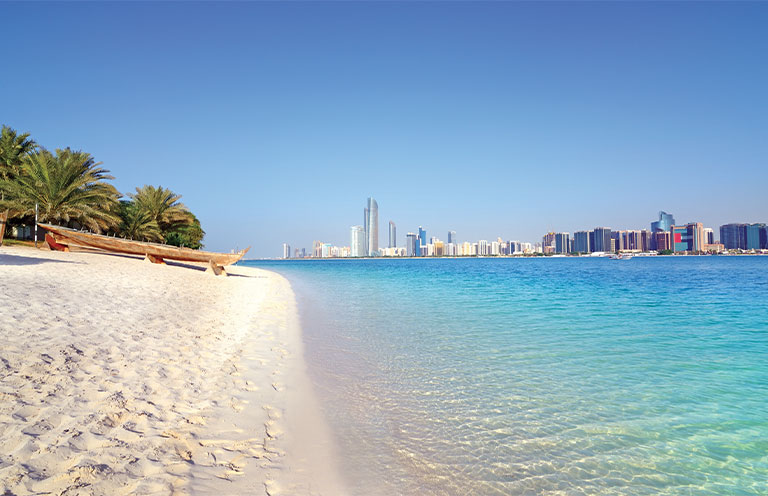
Abu Dhabi: The capital city
My journey began on Etihad Airways, the national airline of the UAE, which offers direct flights from New York; Washington, DC; Chicago and, most recently, Boston, to Abu Dhabi. Business-class tickets include chauffeur service to and from the airport. The airline operates out of the newly built $3 billion Terminal A at Zayed International Airport, which was recently awarded the World’s Most Beautiful Airport by the Prix Versailles. Americans don’t need a visa prior to entering the UAE—they are automatically granted one upon arrival—and when returning, they can clear US Customs before boarding, avoiding long lines upon arrival after the flight, which takes 12-plus hours nonstop to the US East Coast.
The capital of the UAE, Abu Dhabi has historical significance and is a global financial hub. With reportedly 116,500 millionaires living in the UAE—and Abu Dhabi’s sovereign wealth fund estimated at nearly $1.7 trillion—wealth is a way of life. Nevertheless, the vibe in Abu Dhabi seemed demure compared with neighboring Dubai, which is known for its glitz and glamour. Abu Dhabi doesn’t appear to be ostentatious, but rather prideful about its heritage with an understated air of abundance.
Emirati women wear the required abaya—a long, flowing black robe—as well as a hijab to cover their hair and neck, but most also sport high-end designer shoes peeking out from underneath. When visiting a mosque, visitors are required to wear loose-fitting clothing that covers their arms and legs, and women must also wear a headscarf. In urban areas, women should dress conservatively in long pants and a long-sleeved blouse, though casual wear is acceptable at resorts and some tourist attractions.
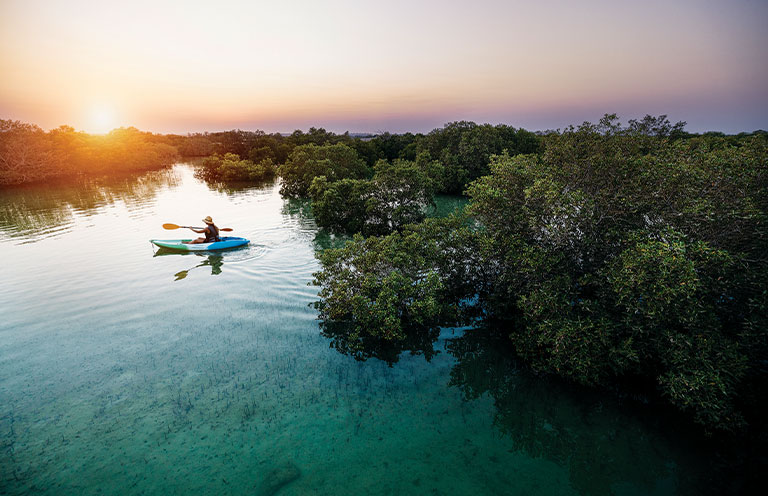
Astounding architecture
Abu Dhabi, an archipelago made up of more than 200 islands, is steeped in natural beauty. Outdoor adventures range from kayaking through serene mangrove forests to strolling picturesque beaches along the Persian Gulf.
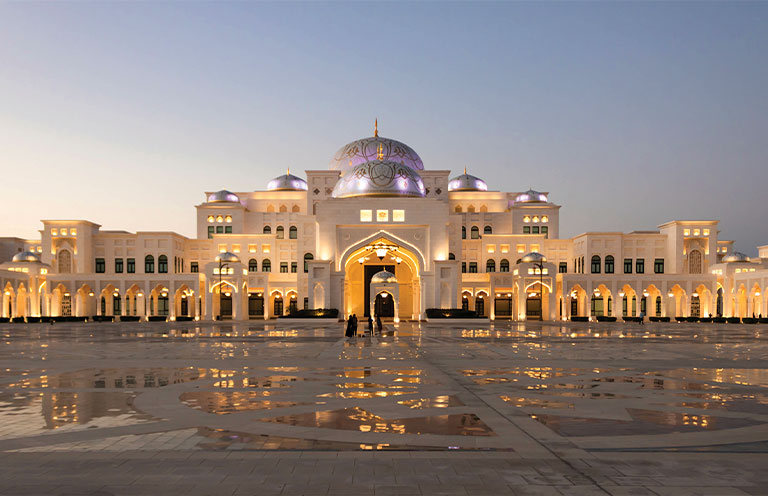
But it is the city’s architecture that will command your attention. Upon entering the opulent Qasr Al Watan—an active presidential palace—I was overwhelmed by the massive double doors (with intricate 23-karat gold-leaf designs) and ornate domes with detailed mosaic artistry and jaw-dropping chandeliers, including one with 350,000 gleaming crystals. The palace opened to the public in 2019 and was quickly deemed the World’s Leading Cultural Tourist Attraction by the World Travel Awards.
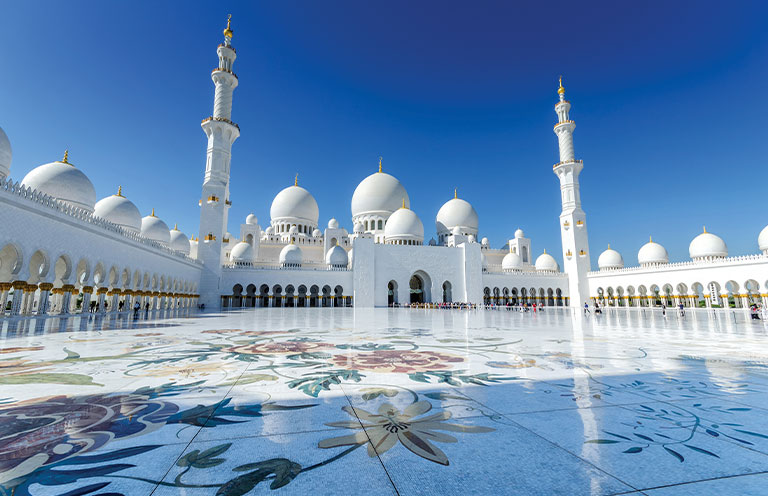
Drawing nearly 7 million visitors annually, the most popular place of interest in Abu Dhabi is the remarkable Sheikh Zayed Grand Mosque, which can accommodate 55,000 worshippers. It was constructed with more than 100,000 tons of white marble and features six Swarovski chandeliers covered in 24-karat gold—the largest being almost 50 feet tall. The grandeur of the mosque was humbling and its craftsmanship breathtaking.
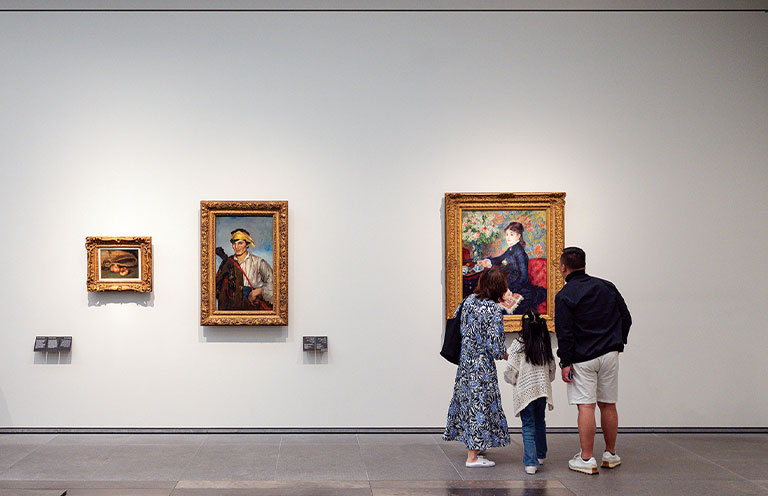
Another exceptional example of modern architecture is the Louvre Abu Dhabi. The world-class art collections are amazing, with pieces from renowned artists such as Renoir, Monet and Picasso, but I was also astonished by the floating dome ceiling. Inspired by overlapping palm fronds, the stainless steel and aluminum dome is made from 7,850 star shapes that allow dappled sunlight to cast creative shadows below.
Abu Dhabi is also for thrill-seekers. At Yas Island, home to multiple theme parks and other entertainment options, I was flung around on twisty roller coasters at Ferrari World, home to the world’s fastest roller coaster (nearly 150 miles per hour), and whizzed around a challenging track in a go-kart at Yas Marina Circuit. I attended the annual Formula 1 Grand Prix with celebrity drivers zooming by in a blur at mind-blowing speeds.
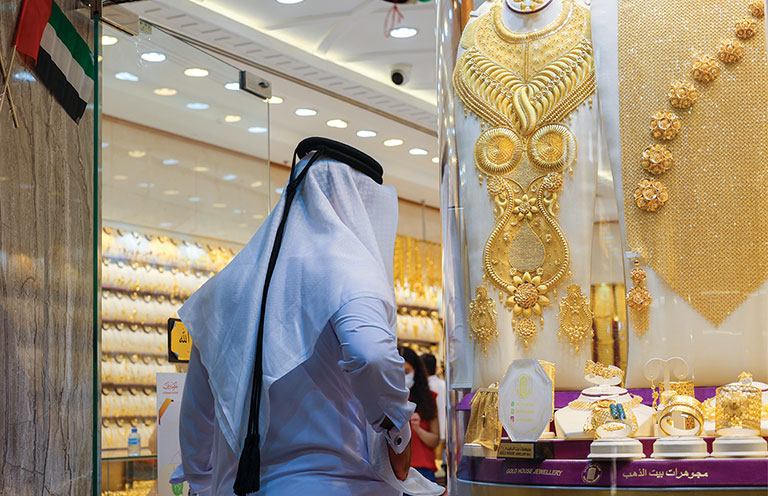
Dubai: The city of gold
A little more than an hour’s drive from Abu Dhabi, Dubai dazzles with innovative technology, iconic landmarks, world-class dining and a futuristic skyline, luring visitors seeking excitement and ultra luxury. People here dress (and drive) to impress, with designer clothes and luxe cars being commonplace.
Dubai is nicknamed the City of Gold for the bustling Dubai Gold Souk, the world’s largest gold bazaar. You can haggle with the more than 380 retailers over tax-free prices for fine gold jewelry as well as bullion bars and coins.
The most populated city in the UAE, Dubai is home to roughly 3.5 million residents, an estimated 85 percent of whom are expats, making it a melting pot of cultures. The bustling city is where A-listers and high-net-worth travelers come to play, shop and dine. It’s come a long way from its humble pre-oil beginnings to now being the fastest-growing city in the UAE, fueled by tourism, real estate and tax-free incentives.
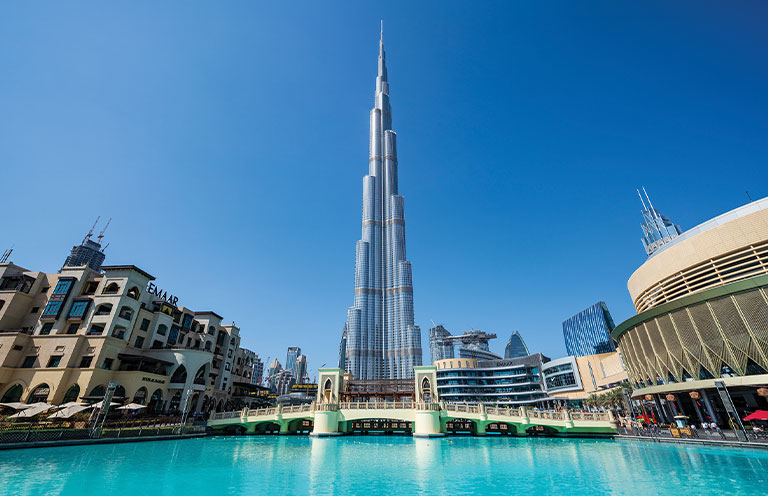
World records
Dubai is renowned for over-the-top attractions and for setting world records. The most popular tourist destination is Burj Khalifa, the world’s tallest building. Towering at 2,717 feet tall with 163 floors, it attracts about 17 million visitors a year. From the observation decks on level 124 and 125, I had a bird’s-eye view of the sprawling metropolis below, including the Dubai Fountain—the world’s tallest musical fountain, where water soars up to 500 feet high.
With a climate that reaches beyond 100 degrees in the summer, there are plenty of record-setting indoor attractions, including Ski Dubai (located in the Mall of Emirates), the first indoor ski resort to feature a Black Diamond run. As an avid skier, I just had to try skiing in a desert. My ticket not only included the rental of ski gear but also ski pants and a jacket. Swooshing down the slope, I appreciated the consistency of the 100 percent human-made snow.
Other records include the deepest pool (the nearly 200-foot-deep Deep Dive Dubai) and largest Ferris wheel (820-foot-tall Ain Dubai).
. . . . .
After spending time in Abu Dhabi and Dubai, I realized that both offer an oasis. The snowy indoor slopes and a sky-high infinity pool in Dubai offer a reprieve from the desert heat, while the gleaming white marble and dazzling chandeliers in Abu Dhabi present a contrast to the surrounding barren landscape. Each city has its own personality, yet both offer a rich cultural experience that is a feast for the senses. And none of it is a mirage.
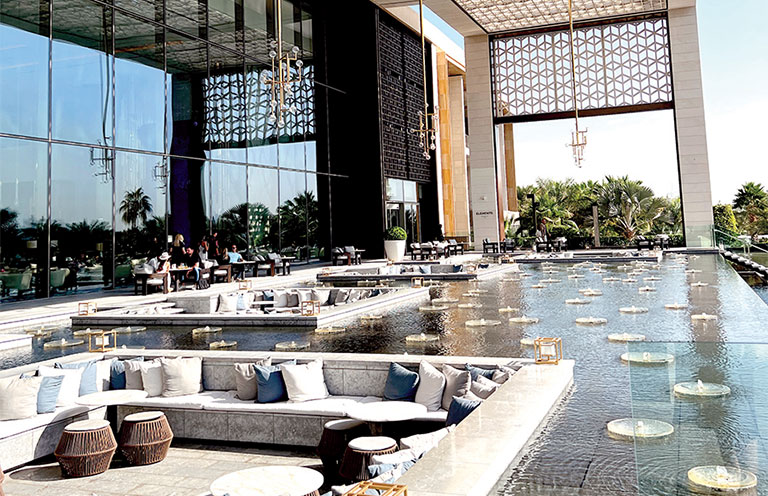
Atlantis, The Royal
While the Burj Al Arab hotel in Dubai is often hailed as the epitome of luxury—and referred to as the world’s only seven-star hotel—Atlantis The Royal, also in Dubai, purportedly rents out the world’s most expensive hotel room: the $100,000-a-night Royal Mansion. It also offers a Nobu-operated pool and beach club, eight celebrity chef-led restaurants, a massive jellyfish tank (home to 4,000 jellyfish) and access to the water park Aquaventure World at Atlantis, The Palm.
